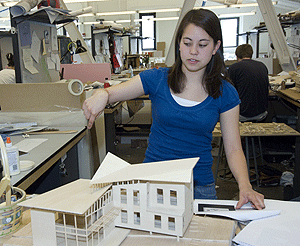The Hoffman Triangle in New Orleans lies below sea level, sandwiched between the levees of Lake Pontchartrain on the north and the high banks of the Mississippi River to the south.
During Hurricane Katrina, floodwaters rose about 9 feet, destroying two-thirds of the neighborhood’s housing.

Yet even before Katrina, “the Hoffman Triangle was facing lots of problems,” says Carolyn Wong, who will receive a bachelor’s degree in architecture May 18 from the Sam Fox School of Design & Visual Arts’ College of Architecture.
Fraying institutions, vacant land and abandoned properties exacerbated high rates of poverty and crime. “The hurricane just brought these issues more to light,” Wong says.
Wong, along with classmate Rebecca Castellon, has spent most of the spring semester crafting an ambitious new master plan for the Hoffman Triangle.
As part of the architecture studio “Rebuilding New Orleans,” the pair visited the area and spent months developing strategies to address some of the neighborhood’s most pressing problems.
Their final thesis tackles everything from water management to housing design to energy conservation.
“The Hoffman Triangle is one of the city’s most difficult areas, but this is a legitimate proposal,” says Derek Hoeferlin, affiliate assistant professor of architecture, who led the studio.
“They didn’t just try to redo everything,” adds Hoeferlin, a former New Orleans resident and now project manager for H3 Studio Inc., one of five firms coordinating rebuilding scenarios for the Unified New Orleans Plan. “They carefully assessed the extent of damage and dealt with conditions on the ground.”
Wong, who grew up in Aurora, Ohio, won state and national awards for art in high school, but as college approached, she began contemplating a career in architecture.
“I don’t think I knew exactly what architecture was,” she says with a laugh. “I wanted to pursue something that combined art with other disciplines — math, science, industry — and architecture seemed to fit.”
Wong excelled in the program, receiving the College of Architecture’s Leslie J. Laskey Outstanding Sophomore Book Award and the Elizabeth S. Schmerling and the Philip Richardson Shepley memorial scholarships.
Nominated as a Fitzgibbon Scholar, last fall she served as architecture’s senior representative at convocation and this spring was undergraduate speaker at architecture’s scholarship dinner.
She has worked as an assistant set designer for the Performing Arts Department in Arts & Sciences and as a painter and sculptor for the Shakespeare Festival of St. Louis.
|
Sam Fox Schoolof Design &Visual Arts,College of Architecture |
For the past two summers, Wong interned with the Cleveland firm Westlake Reed Leskosky, creating models for the Oberlin Conservatory of Music and The Cleveland Museum of Art’s Gartner Auditorium.
She spent a junior semester in Florence, Italy, where the links between daily life and built environment impressed her.
“Florence has iconic architecture,” Wong says. “But it was even more interesting to see how buildings are used — how people occupy them, how they influence local culture.”
Such concerns and an eye toward the future have informed much of Wong’s work on the Hoffman Triangle.
For example, Wong and Castellon address the FEMA guideline for raising homes at least two feet above base flood elevation with a kind of terracing, sloping the ground beneath homes upward. Low areas between homes would be linked to form a series of retention ponds, which would help control flooding by draining excess water to a nearby pumping station.
New buildings would be designed to capitalize on natural resources, allowing natural light and ventilation
“We chose light gauge steel construction because it’s durable, water resistant and termite resistant,” Wong says. “In the event of another hurricane, it can also be recycled.
“We want to take the entire neighborhood off the grid, meaning that it supplies its own energy and water,” she continues.
To that end, rainwater is collected in individual cisterns, while roof-mounted solar panels meet most electrical needs.
“Any extra energy goes into a community battery bank to be stored until needed,” Wong explains. “In the event of another emergency, we want the neighborhood to be able to sustain itself.”